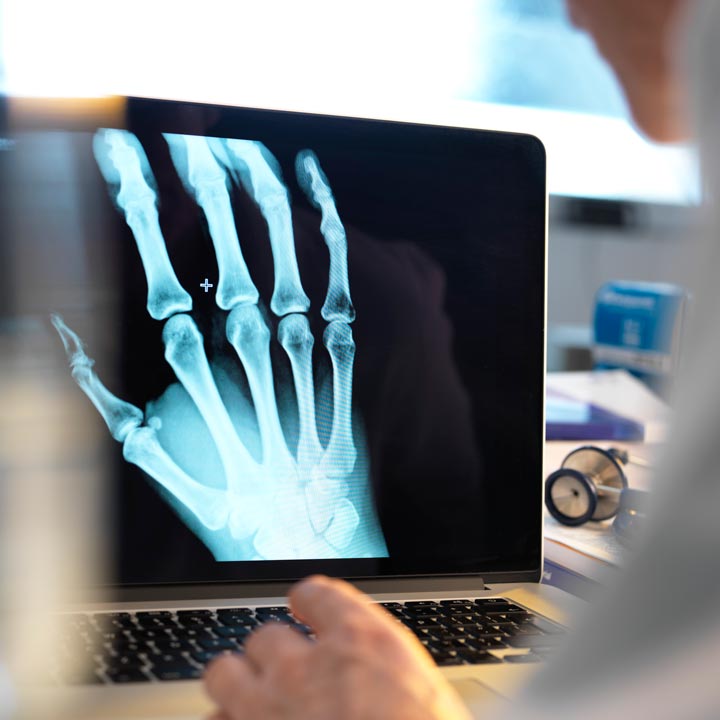 Minimally invasive hand surgery is nothing new. But at The Ohio State University Wexner Medical Center, new applications of the surgery are changing the way common hand and upper extremity conditions are treated — benefiting patients and physicians alike.
Minimally invasive hand surgery is nothing new. But at The Ohio State University Wexner Medical Center, new applications of the surgery are changing the way common hand and upper extremity conditions are treated — benefiting patients and physicians alike.
Orthopedic surgeon Hisham Awan, MD, who specializes in hand and upper extremity care, is one of several Ohio State Wexner Medical Center doctors leading the charge. He’s performed endoscopic carpal tunnel release procedures since beginning his practice in 2010. And with increased experience and advances in technology, his surgical repertoire has grown.
Today, roughly 50% of the operations Dr. Awan does involve a minimally invasive approach, and nearly all are done on an outpatient basis. What’s more, he performs some of these surgeries in an office setting as opposed to an operating room, with patients receiving only local anesthetic.
“We are at the forefront of the latest minimally invasive techniques,” Dr. Awan says.
New tools, smaller incisions, exceptional results
In addition to carpal tunnel release, other minimally invasive hand and upper extremity surgeries the Ohio State Wexner Medical Center orthopedic surgeons perform include arthroscopy of the finger joints, wrist, elbow and base of the thumb; percutaneous fracture fixation; and cubital tunnel release.
Smaller arthroscopes and advanced implants that can be placed with less dissection make these options possible, according to Dr. Awan. The significant number of procedures surgeons with the Ohio State Wexner Medical Center perform helps, as well.
“As you get more experience and become more familiar with the anatomy, your incisions get smaller and smaller,” Dr. Awan says.
Endoscopic carpal tunnel release can be completed with, at most, a 1-centimeter incision at the wrist, as opposed to the 2- to 3-centimeter incision down the palm that’s required in traditional, open surgery. Metacarpal and other hand fractures can be treated through an incision of just a couple of millimeters near the knuckle. A guidewire is placed down the middle of the bone and hand, and intramedullary screws developed in the last several years are delivered over the wire. The process is much simpler and easier on patients than traditional open surgery involving plates and screws.
Patients and surgeons benefit
Nearly everyone requiring carpal tunnel release would benefit from an endoscopic procedure, according to Dr. Awan. The exception might be patients who have had a prior surgery and those who are obese.
When a surgeon is comfortable with a patient’s anatomy, the risk of these operations is minimal, Dr. Awan says. And the rewards can be great.
Most notably, patients have significantly less pain. An open procedure requires greater dissection and leads to more scarring that, in turn, makes patients more prone to stiffness, particularly in the fingers. With less postoperative pain, there’s a decreased need for narcotic medications.
Ultimately, patients have a quicker overall recovery, as well. And that leads to increased patient satisfaction. One study involving laborers found that recovery from endoscopic carpal tunnel release occurred in about three weeks, roughly half the time of recovery for patients undergoing a traditional, open operation, Dr. Awan says.
Add to that the ease, convenience and cost-effectiveness of an office procedure as opposed to a trip to a surgery center, and it’s easy to see why patients are likely to request minimally invasive hand and upper extremity surgery moving forward.
Patients aren’t the only ones to benefit, however. For surgeons, minimally invasive procedures can be more efficient than open operations. And happy, healthier patients is always a goal.
“Having our patients satisfied with a great outcome and being more efficient, that’s a win all around,” Dr. Awan says.
Looking ahead
Dr. Awan believes that in the future, indications for minimally invasive hand and upper extremity surgery are likely to grow as technology expands. He and his colleagues will be ready.
“In our medical center and in our hand center, we have a commitment to continuing education and learning the most cutting-edge techniques for the benefit of our patients,” Dr. Awan says. “We’re focused on advancing our field to get the best patient outcomes.”
